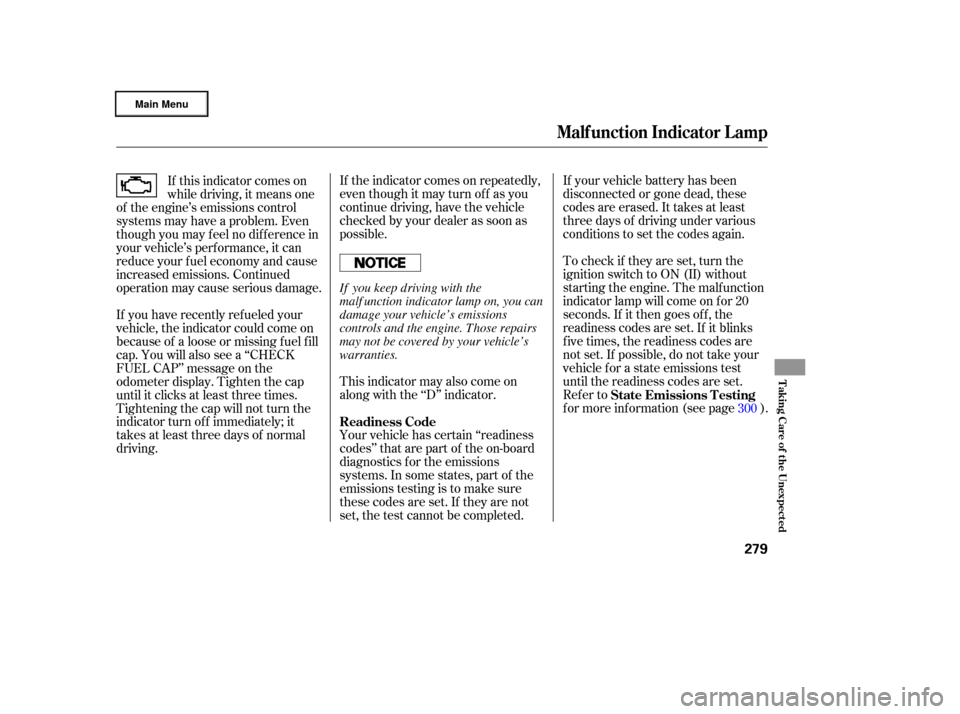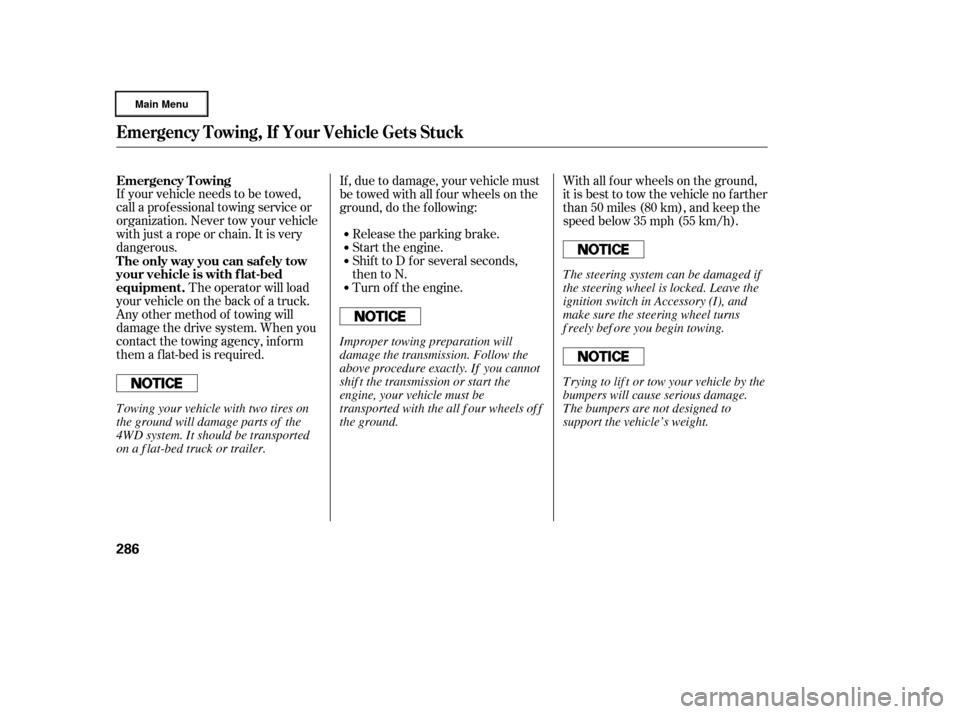Page 282 of 320

If your vehicle battery has been
disconnected or gone dead, these
codes are erased. It takes at least
three days of driving under various
conditions to set the codes again.
If the indicator comes on repeatedly,
even though it may turn of f as you
continue driving, have the vehicle
checked by your dealer as soon as
possible.
This indicator may also come on
along with the ‘‘D’’ indicator.
Your vehicle has certain ‘‘readiness
codes’’ that are part of the on-board
diagnostics f or the emissions
systems. In some states, part of the
emissions testing is to make sure
these codes are set. If they are not
set, the test cannot be completed. To check if they are set, turn the
ignition switch to ON (II) without
starting the engine. The malf unction
indicator lamp will come on f or 20
seconds. If it then goes of f , the
readiness codes are set. If it blinks
f ive times, the readiness codes are
not set. If possible, do not take your
vehicle f or a state emissions test
until the readiness codes are set.
Refer to
f or more inf ormation (see page ).
If this indicator comes on
while driving, it means one
of the engine’s emissions control
systems may have a problem. Even
though you may f eel no dif f erence in
your vehicle’s perf ormance, it can
reduce your f uel economy and cause
increased emissions. Continued
operation may cause serious damage.
If you have recently ref ueled your
vehicle, the indicator could come on
because of a loose or missing f uel f ill
cap. You will also see a ‘‘CHECK
FUEL CAP’’ message on the
odometer display. Tighten the cap
until it clicks at least three times.
Tightening the cap will not turn the
indicator turn of f immediately; it
takes at least three days of normal
driving. 300
Readiness Code State Emissions Testing
Malf unction Indicator L amp
T aking Care of t he Unexpect ed
279
If you keep driving with the
malf unction indicator lamp on, you can
damage your vehicle’s emissions
controls and the engine. Those repairs
may not be covered by your vehicle’s
warranties.
�����—�
���—�����y�
�������������y���
�(�����������y���������y
Page 289 of 320

If your vehicle needs to be towed,
call a prof essional towing service or
organization. Never tow your vehicle
with just a rope or chain. It is very
dangerous.The operator will load
your vehicle on the back of a truck.
Any other method of towing will
damage the drive system. When you
contact the towing agency, inf orm
them a f lat-bed is required. If , due to damage, your vehicle must
be towed with all f our wheels on the
ground, do the f ollowing:
Release the parking brake.
Start the engine.
Shif t to D f or several seconds,
then to N.
Turn of f the engine. With all f our wheels on the ground,
it is best to tow the vehicle no farther
than 50 miles (80 km), and keep the
speedbelow35mph(55km/h).
Emergency T owing
The only way you can saf ely tow
your vehicle is with f lat-bed
equipment.
Emergency Towing, If Your Vehicle Gets Stuck
286
Towing your vehicle with two tires on
the ground will damage parts of the
4WD system. It should be transported
on a f lat-bed truck or trailer. Improper towing preparation will
damage the transmission. Follow the
above procedure exactly. If you cannot
shif t the transmission or start the
engine, your vehicle must be
transported with the all f our wheels of f
the ground.The steering system can be damaged if
the steering wheel is locked. Leave the
ignition switch in Accessory (I), and
make sure the steering wheel turns
f reely bef ore you begin towing.
Trying to lif t or tow your vehicle by the
bumpers will cause serious damage.
The bumpers are not designed to
support the vehicle’s weight.
�����—���
�—�����y�
�������������y���
�(�����������y�������
�y
Page 290 of 320
If your vehicle gets stuck in sand,
mud, or snow, call a towing service
to pull it out (see the previous page).
For very short distances, such as
f reeing the vehicle, you can use the
tie down hooks on the lower lef t of
the f ront and rear bumpers.
If Your Vehicle Gets Stuck
If Your Vehicle Gets Stuck
T aking Care of t he Unexpect ed
287
FRONTREAR
TIE DOWN
HOOK TIE DOWN
HOOK
‘‘Rocking’’ your vehicle between
f orward and reverse gear or revving up
the engine and allowing the wheels to
spin f reely at high speeds can damage
the automatic transmission. Use a tow
service to prevent transmission damage.
�����—���
�—�����y�
�������������y���
�(�����������y���������y
Page 293 of 320
Your vehicle has several identif ying
numbers in various places.
The vehicle identif ication number
(VIN) is the 17-digit number your
dealer uses to register your vehicle
f or warranty purposes. It is also
necessary f or licensing and insuring
your vehicle. The easiest place to
find the VIN is on a plate fastened to
the top of the dashboard. You can
seeitbylookingthroughthe
windshield on the driver’s side. It is
also on the certification label
attached to the driver’s doorjamb,
and is stamped on the engine
compartment bulkhead. The VIN is
also provided in bar code on the
certif ication label.
Identif ication Numbers
290
VEHICLE IDENTIFICATION NUMBERCERTIFICATION LABEL
�����—�
���—�����y�
�������������y���
�(�����������y���������y
Page 294 of 320
The engine number is stamped into
the engine block. It is on the f ront.
The transmission number is on a
label on top of the transmission.
Identif ication Numbers
Technical Inf ormation
291
ENGINE NUMBERAUTOMATIC TRANSMISSION NUMBER
�����—�
���—�����y�
�������������y���
�(�����������y���������y
Page 295 of 320

�Î�Î
�Î
�Î
�Î
�µ�µ �Î
�Î
�Î
�Î
�Î
Specif ications
292
Capacities
Dimensions
Weights
Air Conditioning 1.64 US gal (6.2
)
2.14 US gal (8.1)
4.5 US qt (4.3
)
4.2 US qt (4.0
)
5.3 US qt (5.0
)
3.3 US qt (3.1)
8.6 US qt (8.1)
206.7 in (5,250 mm)
78.0 in (1,980 mm)
70.3 in (1,785 mm)
2.79 US qt (2.64
)
3.01 US qt (2.85)
0.45 US qt (0.43
)
0.48 US qt (0.45)
0.16 US gal (0.6
) 4.8 US qt (4.5
)
Excluding the oil remaining in the engine. Including the coolant in the reserve tank and that remaining in the
engine.
Reserve tank capacity:
Fuel tank
Engine
coolant
Engine oil
Automatic
transmission
fluid
Rear
differential
fluid
Transfer
assembly
fluid
Windshield
washer
reservoir
Length
Width
Height
Wheelbase
Track
122.0 in (3,100 mm)
67.1 in (1,705 mm)
66.9 in (1,700 mm) 22.01 US gal (83.3
)
See the tire information label
attached to the driver’s doorjamb.
Gross vehicle weight rating
Gross combined weight
rating (GCWR)
Maximum load limit
(Payload)
The GCWR must be reduced 2 percent for every 1,000 feet (305
meters) of elevation.
Refrigerant type
Charge quantity
Lubricant type HFC-134a (R-134a)
21.2 23.0 oz (600 650 g) ND-OIL8 Approx.
Front
Rear
1:
2:Change
Total
Change
Including
filter
Without
filter
Total
Change
Total
Change
Total
Change
Total
10,088 lbs (4,575 kg)
1:
2:
3: On vehicles without moonroof or navigation system 1,530 lbs (690 kg)
1,480 lbs (670 kg)
On vehicles with moonroof and navigation system
1 1
2
2
3
�����—�����—�����y�
�����������
�y���
�(�����������y���������y
Page 296 of 320

�µ
�µ
�µ
�µ
�µ
�µ
�µ
�µ
�µ
�µ
�µ
�µ
�µ
�µ
�µ
�µ
�µ
Specif ications
Technical Inf ormation
293
Fuses
Battery Engine
Alignment
Tires
Lights
60/55 W (HB2)
12 V
12 V 28/8 W
12 V 21 W
12 V 21/5 W
12 V 18 W
12 V 3 CP
12 V 3 CP
12 V
12 V 8W
5W
12 V 3 CP
12 V 1.4 W Interior
Under-hood
See page285or the fuse label
attached to the inside of the fuse
box lid under the dashboard.
See page284or the fuse box lid.
Capacity 12 V 12 V
3.8 W
2W
12 V 3.4 W Type
BorexStroke
Displacement
Compression ratio
Spark plugs
Toe-in
Camber
Caster
Size
Pressure3.50 x 3.66 in (89.0 x 93.0 mm)
211.8 cu-in (3,471 cm
)
10.0 : 1
IZFR5K-11
SKJ16DR-M11
0.00 in (0.0 mm)
0.00 in (0.0 mm) 0°50’
0°50’
1°53’
P245/65R17 105S
T165/90R17 105M
32 psi (220 kPa , 2.2 kgf/cm
)
60 psi (420 kPa , 4.2 kgf/cm)
Headlights
Front turn signal/Parking/
Hazard lights
Rear turn signal/hazard lights
Brake/Taillights
Back-up lights
License plate lights
High-mount brake lights
Individual map lights
Bed lights
Console compartment light
Glove box light
Vanity mirror light
Door courtesy lights
12 V 72 AH/20 HR
Front/Rear
Spare
Front/Rear
Spare Front
Rear
Front
Rear
Front
Front
Rear
NGK:
DENSO:
High/Low
(Amber)
Water cooled 4-stroke SOHC VTEC,V6 gasoline engine
�����—�
���—�����y�
�����������
�y���
�(�����������y���������y
Page 300 of 320

�Î
�ÎThe burning of gasoline in your
vehicle’s engine produces several by-
products. Some of these are carbon
monoxide (CO), oxides of nitrogen
(NOx), and hydrocarbons (HC).
Gasoline evaporating f rom the tank
also produces hydrocarbons. Con-
trolling the production of NOx, CO,
and HC is important to the environ-
ment. Under certain conditions of
sunlight and climate, NOx and HC
react to f orm photochemical ‘‘smog.’’
Carbon monoxide does not contri-
bute to smog creation, but it is a
poisonous gas. The United States Clean Air Act
sets standards f or automobile
emissions. It also requires that
automobile manufacturers explain to
owners how their emissions controls
workandwhattodotomaintain
them. This section summarizes how
the emissions controls work.
In Canada, Honda vehicles comply
with the Canadian emission
requirements, as specif ied in an
agreement with Environment
Canada, at the time they are
manuf actured.
Your vehicle has a positive
crankcase ventilation system. This
keeps gasses that build up in the
engine’s crankcase f rom going into
the atmosphere. The positive
crankcase ventilation valve routes
them from the crankcase back to the intake manif old. They are then
drawn into the engine and burned.
As gasoline evaporates in the f uel
tank, an evaporative emissions
control canister f illed with charcoal
adsorbs the vapor. It is stored in this
canister while the engine is of f . Af ter
the engine is started and warmed up,
the vapor is drawn into the engine
and burned during driving.
The onboard ref ueling vapor
recovery (ORVR) system captures
the f uel vapors during ref ueling. The
vapors are adsorbed in a canister
f illed with activated carbon. While
driving, the f uel vapors are drawn
into the engine and burned of f .
Emissions Cont rols
The Clean Air Act
Crankcase Emissions Control
System
Evaporative Emissions Control
System
Onboard Ref ueling Vapor
Recovery
Technical Inf ormation
297
�����—�
���—�����y�
�������������y���
�(�����������y���������y